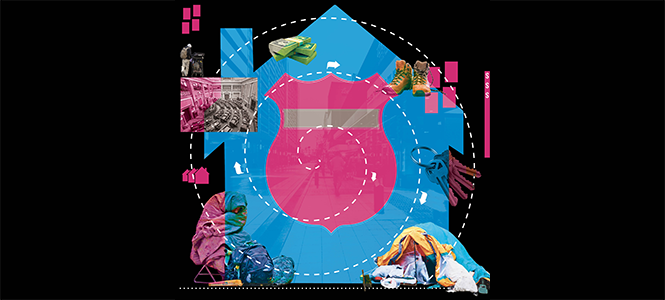
The following story was funded by the Economic Hardship Reporting Project and reported by The Utah Investigative Journalism Project in partnership with Salt Lake City Weekly, KUER, the Standard Examiner and The Spectrum.
It's Dec. 28, 2022, and a white Christmas has come and gone. On this morning, Salt Lake City is soaked from snow followed by freezing rain.
Behind the Rio Grande Depot on 500 West, a small cluster of people experiencing homelessness have set up tents and have taken a break from the numbing weather to dry out blankets and sleeping bags on a nearby chain link fence.
One individual, who gave his name as Chris, was dressed in the only warm clothes he had—a full-length Santa Claus suit he borrowed from a friend.
Like others here, Chris avoids the shelters because they exacerbate his anxiety. When told that Salt Lake City had spent millions of dollars through a recent grant from a homeless fund to hire police officers, Chris said he was disappointed and felt more should be put toward mental health services.
Police are a mixed bag in Chris' view. Some homeless people are absolutely terrified of them. Often, he said, their experience with the police is that of being herded from one spot to another. "There's been times I've literally woken up in the gutter to hear officers saying, 'Hey bud, you got to go, you gotta keep on moving,'" Chris said.
Being homeless means always being in motion, beating sore feet across the pavement all day, sleeping where you can and, too frequently, waking up to an officer repeating one of their common sayings: "You're allowed to be somewhere, you're not allowed to stay somewhere."
Still, Chris said he has noticed a shift recently.
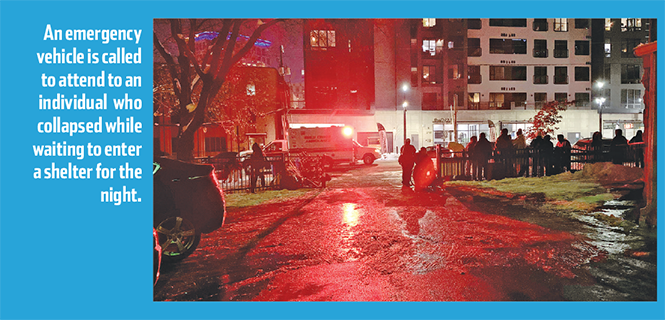
"It's a stark difference to being woken up and yelled and screamed at and told you have to go, versus waking up and being told 'Hey you gotta go' and being handed a bottle of water and a granola bar," Chris said. "You see those little differences. I see the little things they do that show their humanity."
In 2022, the Utah Legislature more than doubled the amount in its Homeless Shelter Cities Mitigation Fund. The account distributes grants to cities where homeless shelters and resource centers are located to help them deal with the impacts on their communities.
The fund allows cities to spend their dollars either on police or on social services and other expenses to address the root causes of homelessness. And since more than $10 million was doled out in the summer of 2022, eight cities across the state—from Logan to St. George—have overwhelmingly spent the grant funding on police.
More than $8.6 million—or 91% of the funds—went to public safety expenditures. Another 5%, or just under half a million dollars, went to social services and another 4%, just under $400,000, went toward support services for communities and neighborhoods.
While the fund was geared to helping cities deal with the negative impacts of shelters, critics say solely trying to police the problem is a mistake, even with a fund that includes public safety along with social services and other programs.
Bill Tibbitts of the Crossroads Urban Center, an advocacy organization for low-income Utahns, said he understands the need and that crime does unfortunately linger around homeless shelters.
Still, he said, spending on police personnel amounts to a costly treatment for a symptom of homelessness that does nothing to address the underlying problem.
"I think it's a sign the system is failing if you need more funds for first responders rather than services," Tibbitts said.
The Thick Blue Line Item
Cities lobbied the Legislature for the fund to help cover the costs of dispatching police and paramedics to respond to homelessness calls, Tibbitts said. So, it does make sense that public safety is the largest line item of spending from the cities.
"If you find someone passed out in the snow or in the extreme heat, then it's exactly the first responders you want there," Tibbits said. But attacking the root problem requires more. "It takes more creativity to come up with something that reduces the need for police to engage with people experiencing homelessness," he said.
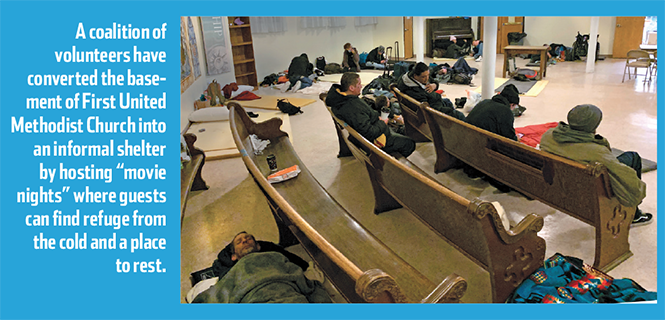
Ogden's $1.7 million from the state fund was used to continue the employment of four new full-time law enforcement officers, three emergency medical services providers and two homeless service advocates.
That brings the city's numbers up to 12 officers and nine EMT's focused on homeless response.
South Salt Lake City hired a homeless strategies director and a homeless strategies coordinator and continued funding 12 full-time firefighters/EMTs and 11 full-time law enforcement employees.
Midvale used the funds to continue paying for six full-time shelter resource officers, three full-time patrol officers and set aside $630,000 for contract fees to the Unified Police Department.
In Midvale's documentation to the Utah Homeless Council, which approves the grants, the city's application notes that: "The half-mile radius around the [Midvale Family Resource Center] represents 13% of Midvale's total area, but 25% the City's public safety calls occur in this area. This shows a disproportionate impact on the surrounding community and is the basis for measuring the impact of the Midvale Family Resource Center."
Salt Lake City used its $2.75 million grant to hire its "Rapid Response Team" of two outreach staffers who meet with the homeless, as well as two business and community liaisons through Volunteers of America and two housing case managers, also through the VOA. But the city spent 83% of its grant funding to not only hire 12 new police officers "dedicated to homeless response" but also to buy new uniforms and equipment for the officers, including ballistic vests, body cameras, duty weapons and even vehicles.
Andrew Johnston, director of Homeless Policy and Outreach in the Salt Lake City Mayor's Office, said it's all about balancing different solutions to the problem. He notes that Salt Lake City funds Volunteers of America (VOA) street outreach teams, and that other outreach groups already operate in county libraries as well.
"We have a lot of those services, and we always need more," Johnston said. "What we didn't have, though, was enough physical folks in the locations around the resource centers."
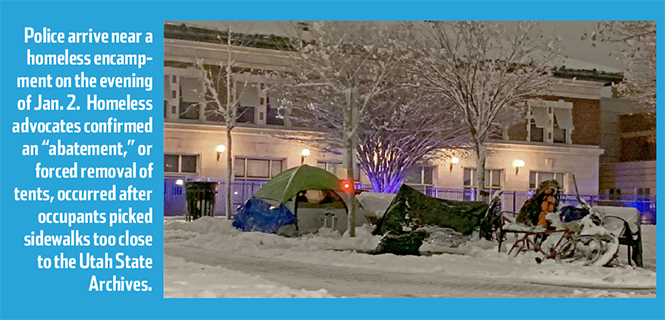
Feedback the city received from residents, businesses and homeless people themselves indicated a need for more law-enforcement presence to protect communities around the shelters and the clients using them, he said. Police were needed, Johnston said, "to build that sense of trust and safety for those who are coming in for services, that they're not going to walk out the door and confront drug dealing or human trafficking or other issues that are not necessarily at the resource center but could come close to it."
While it's true that social services are key, those remedies don't work with every individual, Johnston said. "We can social-work a lot of those folks. But for criminal behavior, it doesn't always work well," he said.
The Right Tools
What does it mean to have police "dedicated to homeless response"? When Salt Lake City spends over $1 million on equipment for new officers, what tools do they have for dealing with the homeless?
It's an issue of concern even for groups not normally focused on homelessness, such as the libertarian think tank The Libertas Institute. Amy Pomeroy, the institute's criminal justice policy analyst, said in a statement that the funds are poorly spent on officers who are ill-equipped to deal with a complicated problem.
"We do police officers a disservice when we expect them to address homelessness, especially when we haven't given them the tools to do so," Pomeroy said. "Really, all an officer can do is arrest someone, drive them to a homeless shelter, or tell them to move along. None of those options is a real solution. Funds would be better spent on addressing the persistent mental illness which is at the root of most chronic homelessness."
Johnston, of Salt Lake City, acknowledged that there is no real training specific to dealing with homeless residents. He said he would hope the dedicated officers would at least undergo crisis intervention training—the kind that helps law enforcement deescalate situations, especially with individuals experiencing mental health crises. But even then, Salt Lake City did not stipulate that the officers would be required to take the training when seeking the grant funding from the state.
Wendy Garvin is an advocate and founder of Unsheltered Utah, a nonprofit that serves the homeless who refuse or are unable to use the shelters. Her organization has helped to set up informal "movie nights" at the First United Methodist Church to allow the homeless extra shelter in a safe space during severe weather.
Garvin has encouraged Salt Lake City to hire more outreach and caseworkers, a development she said has made a huge difference for her clients. She's less enthusiastic about all the new officers hired by cities using the state money. While Garvin applauds the two officers recently hired by South Salt Lake as being very humane and focused on helping the homeless, overall, she feels police can only do so much and, in some settings, can be a problem.
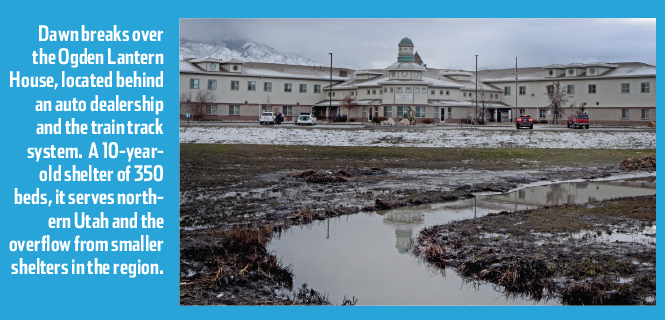
"I think we spend far too much on police resources—for example, the Millcreek [shelter] has a police officer in the first two hours every night checking bags," Garvin said. "That is a deterrent for our unsheltered population. People won't go in there and feel safe."
If a police officer finds a weapon, for example, he or she might fall back on their academy training and question or cite the individual. A private security guard would have more flexibility to just take something from the individual for the night and give it back in the morning.
"That's not a police job, that's a private security job," she said.
Social workers, housing case workers and others can find solutions for the unsheltered. But she said, generally speaking, "police have one tool and that's a hammer—they send them to jail."
A Statewide Problem
Not every grant recipient has used the state funding for police. Logan and Richfield expanded services to domestic violence shelters.
The New Horizons Crisis Center in Richfield was converted from an old nursing home into a 45-bed domestic violence shelter—the only one of its kind in the five rural counties surrounding it, including Sevier, Piute, Millard, Sanpete and Wayne. In recent years, the shelter has had to accommodate more and more individuals experiencing homelessness.
New Horizons director Debbie Mayo said homelessness in rural counties is different than on the Wasatch Front, where the unsheltered congregate in parks and around shelters. "They're kind of more quietly in the corners," Mayo said.
Some individuals might live in run-down trailers with no heat or water, parked on public land. Their needs can be different as well, with one of Mayo's big concerns being helping homeless individuals with gas money or buying them bikes so they can get to workplaces that are spread out far and wide among the small cities and towns.
"There's no public transportation here," she said. "So, there's definitely different barriers in a rural area than in the city."
Different issues, but sprouting from the same causes. Mayo, like her urban counterparts, said the rise in homelessness has been a direct result of a lack of affordable housing and a jump in home prices.

"The limited housing in our area along with everywhere else is the same way," Mayo said. "If you have a job that makes $14 an hour, it's really hard to afford $1,000 a month in rent."
The homeless mitigation grants are not restricted to police and can in fact be used for housing options. Salt Lake City, for example, could have used its grant money, to keep open the Ramada Inn for winter overflow shelter, as it did in 2021.
But Johnston said the city had already invested $26 million in 2022 into deeply affordable housing, and recently helped fund an affordable apartment project with 400 units that will be available in April. This grant, he said, was best used for public safety and outreach even though that's only part of the overall solution.
"These are all things to try and Band-Aid the situation," Johnston said. "I think ultimately this is a housing issue at its core, with some behavioral services attached to it."
But that also means that if cities using the mitigation grant decide to move their funding around and shift it less toward police and more toward social services and outreach, they'll still have police and first responders on the payroll that will have to then be funded by city taxpayers or let go.
For Tibbitts, another problem with the shelter mitigation funding is exactly that, that it tends to force cities to spend the money on police because they don't have other viable alternatives. Smaller cities might not have good housing, rental assistance or social services to expand on with the grant funding, but they already have police and fire departments. Directing the money just to individual cities misses the opportunity for addressing the bigger picture.
"Major homeless services should be at the county level or even a regional level," Tibbits said. "It shouldn't be that if you're homeless in Davis County, you have to go to Salt Lake County to get help."
Garvin, with Unsheltered Utah, agrees that funding needs to happen outside the city. If she had a magic wand, she would wave it to create a 24/7 regional or county mental resource center where individuals could get evaluated without getting locked up or having to go into an emergency room.
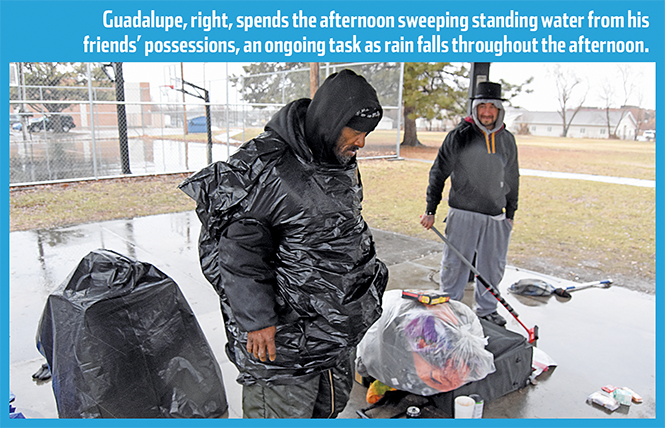
"We have so many people who have been really traumatized by institutions," Garvin said. "Medical institutions, jails or prisons. So it can be very hard for people to go into a big hospital and know they have to go through an ER process when what they are having is a mental health emergency."
Garvin said the Mobile Crisis Outreach Team (MCOT) or crisis workers from the Huntsman Mental Health Institute are other groups that could be expanded and given better training to deal with the unsheltered. Currently, Garvin said the team seems more trained to deal with housed populations. But if there were more crisis team members who were able to meet and treat the homeless on the street without having to first take them into a stressful inpatient setting, it would make a big difference.
People are able to dial 988 to request MCOT teams respond to someone in crisis, but they haven't always been able to respond. In August of 2022, an employee at Fisher Brewery in Salt Lake City dialed 988 regarding a man who came into the business in his underwear and stole beer. Salt Lake City police responded instead, and the unarmed man was shot and killed by the responding officers.
While housing and behavioral health services are not always seen as readily available for smaller jurisdictions, Cedar City Police Chief Darin Adams said his city decided, nevertheless, to try and address root causes.
The city received $123,530 and directed that to rental deposits for individuals and households facing homelessness and emergency hotel and motel vouchers.
The city also wanted to address crime at and around the shelter but opted to leave police out of it. Instead, the grant paid to hire an employee of the Iron County Care and Share who would do both case management with clients and provide security as well.
"It just made sense that someone who could be stationed there doing security, doing outreach, would get to know every one of those individuals and then learn the others who are in the community and then be able to partner with us and our officers in trying to address this issue instead of it being, you know, like many communities being driven from the police department," Adams said. "Because, as you know, homelessness is not illegal, just like being mentally ill is not illegal."